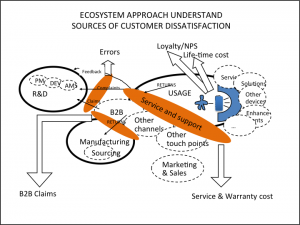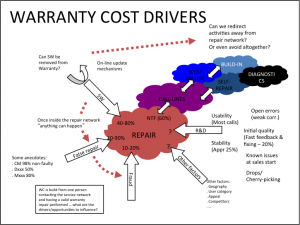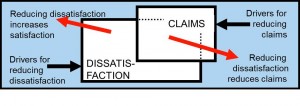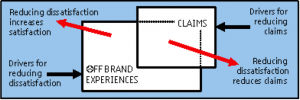In #LeanQuality you strive to proactively reduce the impact from actual and potential sources of dissatisfaction.
Understand the hard and soft implications of customer dissatisfaction.
Take an ecosystem approach to map all potential sources and make specific plans for mitigations where you see the largest impact.
Using the ecosystem approach often makes you see new opportunities for tangible actions in specific parts of your business to factor out significant potential sources of customer dissatisfaction. Starting with the rather fuzzy and abstract approach you are able to derive very tangible guiding metrics to monitor your progress.
It’s all about making customer feedback tangible and about turning it into actionable feedback that you can actually do something about.
To the surprise of many, this is a process that can often not be automated, but requires an constant dialogue between customer facing people and people with technical insight.
For general monitoring purpose, I found in a previous role that the Net Promoter Score (NPS) system can be very effective in weeding out the largest contributors for customer dissatisfaction. Likewise claim and complaint handling systems. Be aware that only a fraction of dissatisfied customers will choose to contact you! And even your most loyal customer may have some pain points – you need to dig them out!
People often ask: why focus on dissatisfaction? The answer is simple. Everyone else is happy to focus on satisfaction.
It’s a bit like a zero-sum game. By reducing dissatisfaction you create more room for satisfaction.
The essence of #LeanQuality is reducing actual and potential sources of customer dissatisfaction!
It’s a place where there are huge contributions to be made. In one of my previous jobs, this approach helped literally halve direct warranty costs.
One useful concept we often used was ON/OFF brand experience. It’s an easy test to make to ask if something is consistent with your desired brand experience or not – is in ON or OFF brand? (This came from a book, but I forgot which :))
===
Eco-system approach: Draw ‘dissatisfaction’ as a circle and list all possible sources contributing to increased dissatisfaction as little streams running into the pool. Once you have the initial picture you can further decorate it with estimated contributions from each source etc etc. Each little stream can be turned into a branch-structure of causal connections etc etc. It will help you get an overview of where you can focus to get the biggest impa ct on reducing dissatisfaction … to create more room for satisfaction. Use e.g. the #AgileEngine approach to drive focused improvements.
ct on reducing dissatisfaction … to create more room for satisfaction. Use e.g. the #AgileEngine approach to drive focused improvements.
The idea can be extended to cover other similar perspectives – drawing out a landscape of contributors or a more specific ecosystem of e.g. repairs.
Example: The first picture shows an example of drawing out the landscape for understanding impacts of customer dissatisfaction – where it is created – where it can be seen – and how it can be measures. This is particularly useful when analyzing what’ s in the KPI level figures and where the most significant contributions come from.
s in the KPI level figures and where the most significant contributions come from.
Example: The second picture maps the drivers of warranty cost – which is based on both actual and perceived product issues. Even fraud is part of the equation.This view is useful to e.g. discuss and analyze how you can change the dynamics of the ecosystem to reduce the number of repairs. E.g. you know for sure that a product not entering a service place will not be services 🙂
=== Wider application
In reality you can apply this to any positive or negative aspect significantly impacting your business – it’s the idea of the eco-system approach and the actionable information/feedback that is key – focusing on most significant impacts.
=== Comment on converting to satisfaction
Interesting article in HBR Nov-15 (The new science of customer emotions) documenting that it’s more financially viable to turn ‘highly satisfied’ customers into ‘fully connected’ ones than turning dissatisfied customers into satisfied ones. The average increase in value from the former conversion is 52%. My comment is that it’s not either or. Traditionally in my experience more people are interested in satisfaction than dissatisfaction, often causing common sources of customer dissatisfaction to remain unchallenged, while armies of customer support people fight the symptoms.
===
Kano model – https://en.wikipedia.org/wiki/Kano_model
===
Post script: In an earlier job I helped bridge the technical and customer facing parts of a large tech organization … to build the feedback channels and drive a continuous dialogue to identify and eliminate potential sources of customer dissatisfaction. At the time it proved to be very effective. It took several years and required development of new infrastructure to get on top of the situation. This is where these experiences are from.
===
See downloads for supporting material
===
Presented at
- GilbFest, 2017

